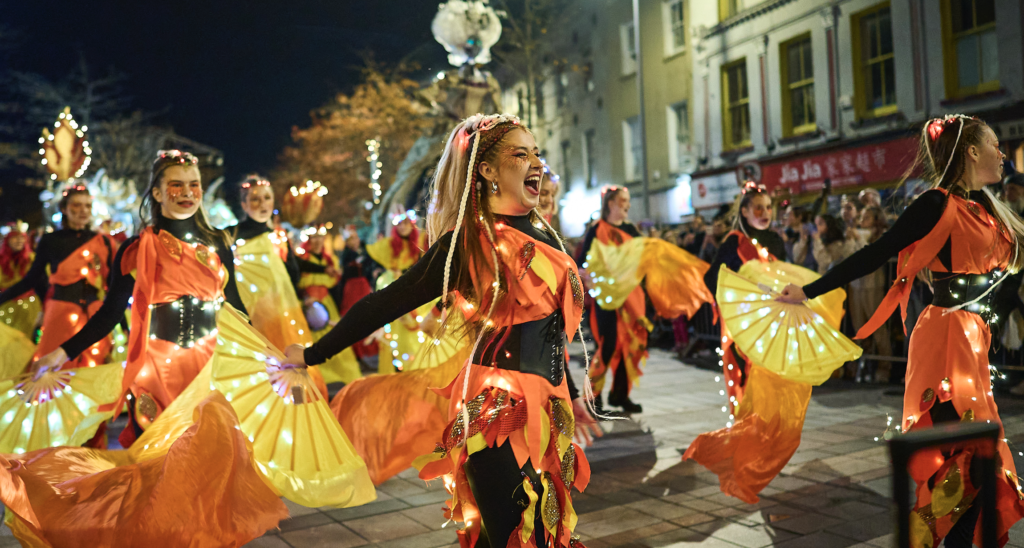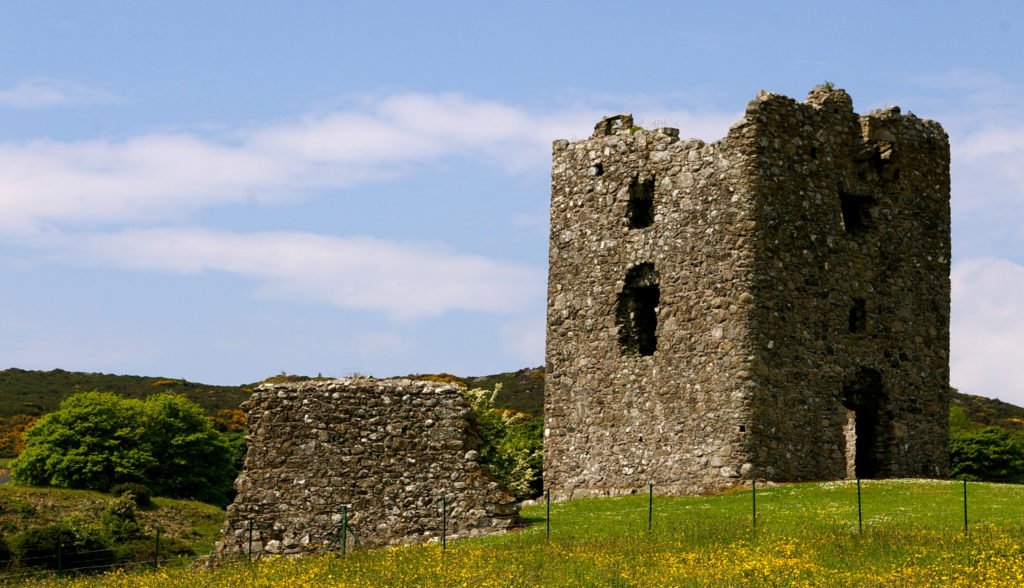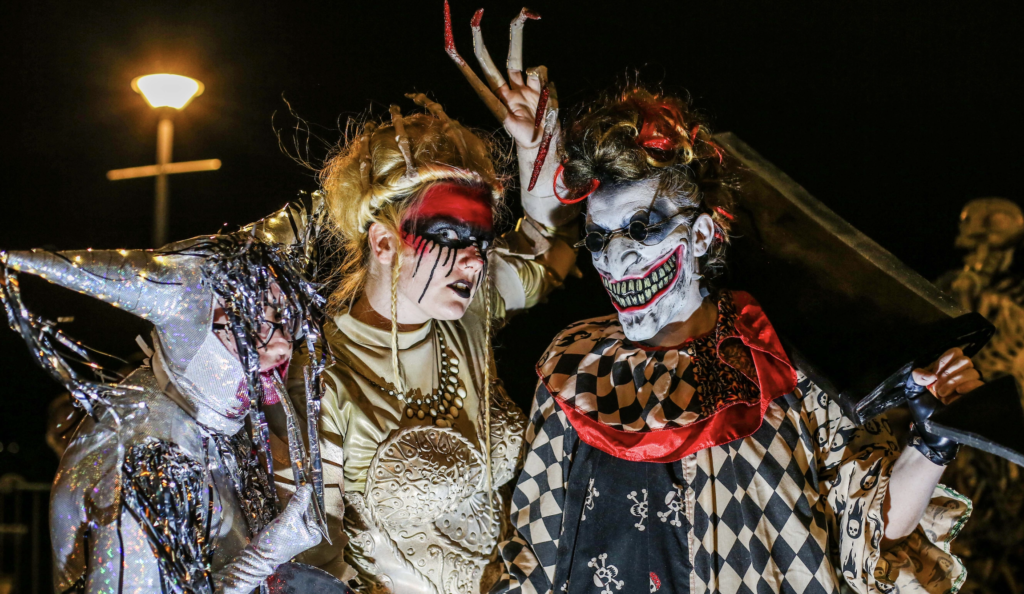HALLOWEEN is the ideal time to visit some of Ireland’s spookiest locations — although, be warned: many of these places are scary the whole year round.
Ireland’s castles, many standing for over a thousand years, have seen plenty of handbags over the centuries — so they’re fertile ground for spirits, ghosts, ghouls, banshees and, of course, the Undead.
These boyos are out and about at this time of the year in large numbers; that’s the word on the street, at any rate.
For a spot of ghost-hunting, the choice is wide: guided castle tours, overnight stays, or merely hiking along lonely paths towards ancient ruins wherein lurks we-know-what-not.
 Take your pick of Halloween festivities in Ireland this month...
Take your pick of Halloween festivities in Ireland this month...The rock star of Meath
OVERLOOKING the plains of Meath, one mile east of Athboy, Tlachtga is a massive rock 390 feet above sea level and commands fine views of the surrounding countryside.
Every Halloween bonfire in Ireland — and indeed the world — can arguably trace its lineage back to a single spark lit on the Hill of Tlachtga near Athboy. This was where the druids of the High Kings once lit the Great Fire of Samhain, marking the Celtic New Year and the moment when the veil between worlds grew thin. They only had to come up from the Hill of Tara in the Boyne Valley — not a long commute, even back in those days.
Archaeological excavations suggest the hill was certainly used for feasting and celebration as far back as 2,000 years ago.
From that sacred blaze, smaller fires were carried to every corner of Ireland, rekindling hearths for the winter ahead. When Christianity absorbed Samhain into All Hallows’ Eve, the custom of fire endured — no longer to honour pagan gods, but to ward off darkness and mischief. Yet its roots remain unmistakably Irish. Every modern bonfire, from Belfast to Boston, is more than likely a faint echo of that ancient flame first kindled on the hill above Athboy more than two thousand years ago.
This year Halloween/Samhain will be formally marked in Athboy with the Lighting of the Samhain Fire at the Fair Green on Oct 31 (free, non-ticketed), as part of the Púca Festival. Guided heritage tours of Tlachtga (Hill of Ward) run Oct 30–Nov 2 with timed slots.
Carnival time in Cork
HALLOWEEN in Cork creates a carnival atmosphere to keep creatures from the Otherworld — the banshees, the ghouls and the poltergeists — at bay. The Dragon of Shandon Festival in Cork is an annual Halloween street parade celebrating Samhain and community art. The event features a giant, 36-foot dragon puppet prowling through Cork’s streets, accompanied by all manner of creatures, beasts, illuminated props, dancers and music.
Organised by Cork Community Art Link, the festival is built through months of community workshops involving local artists, schools and voluntary groups.
This Halloween, the dragon will re-emerge on 31 October at 7pm, weaving from Shandon into the city in a dramatic finale spectacle.
Dark recesses in Dublin
“SOME who have heard him say that he speaks with a Dublin accent.”
That was James Joyce referring to the devil — and he could be right. If he’s to be found anywhere, it could well be in St Michan’s Church, where some of the mummified bodies date back to the 17th century. Accidentally preserved by the dry limestone environment, the bodies are stored in the vaults. The dry air has helped preserve the earthly remains of crusaders, leaders of the 1798 Rebellion, plus the ordinary people of Dublin.
The church offers guided tours that include access to the crypts/underground vaults.
Suspended sentences in Co. Tipperary
THE Aherlow Hanging Tree, also known as the Gallows Tree, stands in the Glen of Aherlow in County Tipperary — a place of haunting beauty and darker folklore. Legend has it that during the 18th and 19th centuries, the ash tree was used for public executions, often of highwaymen and rebels. Its gaunt, twisted branches gave rise to ghost stories of restless spirits haunting the glen, especially on misty nights when the Galtee Mountains loom above.
Today, the tree is both a historical curiosity and a sombre reminder of the area’s turbulent past, where rebellion, retribution and rural myth often intertwined. And of course, there are several resident ghosts. One particular local legend — to some extent backed up by parish records — concerns one poor lad, sometimes given as the local miller’s son, who was hanged from the Aherlow tree in 1798 for sheltering rebels.
They say his mother cut him down before dawn and buried him at the crossroads, but that the rope left a mark around the branch that never healed. You can still see it, say the locals.
On still nights, travellers claim to hear the creak of that rope and see a figure swaying just above the road — not hanging, but watching. Horses shy and dogs refuse to pass. One farmer swore he saw muddy footprints on his doorstep one morning — barefoot, and facing out.
But remember, you’ve got nothing to fear but fear itself; and, of course, anything following you and going “Woooooo wooooo…”
Macabre goings-on at Moyry
 the haunted Moyry Castle in Co. Armagh
the haunted Moyry Castle in Co. ArmaghMOYRY Castle, County Armagh, has seen more than 400 winters guarding the Gap of Ulster. Few signs of comfort are in evidence — not even a set of stone steps to service the three storeys; access was by ladder and ropes only. And definitely no chill-out room.
It was built to withstand musket and cannon, and it was built to last. You can’t stay there, but you probably wouldn’t want to, as it’s haunted night after night. The ghost in question is known as the Priest’s Lady. You can more than likely work out your own back story.
But it makes for a wonderful hike the morning after you’ve been to a traditional music session in the Welcome Inn, Forkhill. The pub’s seanchaí will have the whole lowdown for you.
Murder holes and ghost patrols
LEAP Castle, in County Offaly, has seen more gruesome deaths than a Game of Thrones wedding. It opened for business around the 13th century and earned its living during very hard times.
The very model of impregnability, uninvited guests — of which you can be sure there were many — were treated to boiling water, tar, arrows, rocks and other early weapons of mass destruction, rained down on them from overhead murder-holes. Death was commonplace, hence the reputation: the most haunted castle in Ireland.
Leap Castle takes its name from a suitably tragic incident. The daughter of the O’Carroll chieftain fell in love with an English captain held prisoner in the O’Carrolls’ castle dungeon. Things went predictably badly, and the couple eventually leapt from the battlements.
You’ll probably hear them shrieking and squealing at night — but not in a good way.
Guided tours are available by arrangement.
leapcastle.net
Ghosts at Ballygally
The 17th-century Ballygally Castle, on the spectacular Antrim coast, is home to the spirit of Lady Isabella Shaw. Her husband — never a very woke person — locked her in the turret after she gave birth to a daughter instead of a son. Trying to escape, she fell to her death on the rocks below.
Today Ballygally is a four-star hotel — just keep an eye out for Isabella walking the corridors.
www.ballygallycastlehotel.com
The haunted hermitage
ETHEREAL beings have long haunted the deep, dark forest of Tollymore in County Down — so much so that a significant segment of Game of Thrones was filmed here.
But you don’t need any HBO series to imagine the Otherworld here.
Ghost-spotters should hang out at the Hermitage — two unnervingly lonely stone chambers overlooking a deep salmon pool on the Shimna River. Stone steps lead into a dark, deciduous wood. This is the des res of the Blue Lady, a bereft widow who keens like a banshee.
The Hermitage is one of the oddest follies in this former Victorian demesne, and not really a hermitage at all — but then the Blue Lady isn’t really a ghost. Probably.
Waking in Waterford
YOU could wake in Waterford — but perhaps in an unexpected way. The Irish Wake Museum – Rituals of Death (often called the Wake Museum), part of the Waterford Treasures group of museums, is situated in the eerie 15th-century Almshouse. The exhibition traces the Irish customs, traditions and superstitions associated with death. The unique rituals, superstitions and prayers that are part of an Irish wake are all present and correct. Storytelling from the 15th to the 20th centuries, with different themes associated with death, is regularly on the agenda — and not just at Halloween.
Also in Waterford (obviously a spooky sort of place, so watch out) there’s a bit of a tale round Curraghmore, ancestral seat of the De la Poer and Beresford families. It’s said to be haunted by the spirit of John Power, 2nd Earl of Tyrone. According to legend, he made a pact in youth with his foster-sister Nicola Sophia Hamilton that whoever died first would return to prove the soul’s immortality. Years later, after John’s death, his ghost appeared at her bedside, foretelling her future and leaving a withered mark on her wrist where he touched her. The story, long preserved in family papers and local legend, has lasted for centuries.
Visits to the house can be arranged; or you could hang around late at night outside and see what you make of it.
A shadowy visit to Kilkenny
KILKENNY’S ghost tours plunge you into one of Ireland’s most haunted medieval cities. By night, guides lead groups through narrow lanes, graveyards and past old inns, weaving tales drawn from local lore and dark history. The spookiness is maximised by the almost Transylvanian chill of the looming castle walls.
Kilkenny Ghost Tours operate nightly from Lanigan’s Bar, pointing out the curse of Sir Richard Shee, the 14th-century witch trial of Dame Alice Kyteler, and the banshee whispered in St Mary’s graveyard.
Meanwhile, Kilkenny Haunted Dark Tours wander the Medieval Mile, detailing executions, highwaymen and spirits said to linger in Kyteler’s Inn, Shee Alms House and Kilkenny Castle itself. One legend says sixteen souls drowned when St John’s Bridge collapsed in 1763 — their apparitions still drifting in mist over the Nore.
Haunted by justice
ON A cold March morning in 1711, eight women from the windswept peninsula of Islandmagee in Co. Antrim were marched to Carrickfergus Courthouse, accused of bewitching a young servant girl named Mary Dunbar. She claimed the women tormented her in spirit form, pinning and choking her in her sleep.
Tried under the 1586 Witchcraft Act, the women were convicted in Ireland’s last witch trial and sentenced to a year in prison and public pillory.
Three centuries on, their story still haunts the coastline. A memorial plaque now stands near the Gobbins Visitor Centre, overlooking the same dark waters that once mirrored the witch-fearing age. Ulster University’s Witches of Islandmagee project has revived their tale through exhibitions and even a graphic novel.
Visitors today can follow the eerie trail from Carrickfergus Castle to Islandmagee’s lonely churchyards, where the wind still seems to whisper the women’s names — Jane, Margaret, Ann…
Derry prepares to cast its spell for Halloween 2025
 Derry Halloween Festival gets underway this month
Derry Halloween Festival gets underway this monthTHE City of Bones is stirring once more.
Europe’s biggest Halloween festival returns to Derry from October 28–31, promising four nights of ghosts, fireworks and Celtic mischief along the city’s 400-year-old walls.
The “Awakening the Walled City Trail” launches proceedings on October 28, transforming Derry’s historic streets into seven themed “zones” of light, sound and folklore.
Visitors can brave the Shipquay Shriek, where the Samhain Serpent Sliántha slithers through fire and fog, or join the Disco at the Diamond — a resurrection of the city’s favourite skeleton DJ, Walter de Burgh.
Over at Bishop Street, the Howling She-Wolf and the Wailing Nuns will stalk the cobbles in a chilling display of myth and madness.
At the festival’s heart, the Guildhall Square will glow beneath artist Luke Jerram’s illuminated Samhain Moon, with live music, markets and the mischievous Uncle Doom and his Organ of Gloom adding to the atmosphere.
Food lovers can feast at the new LegenDerry Bites of Terror in Waterloo Place — a street-food “spooktacle” serving everything from devilish drinks to haunted hot dogs.
Families are well catered for with Little Horrors and Freaky Family Fun, including screenings of The Goonies and Wallace & Gromit: The Curse of the Were-Rabbit, pumpkin-carving, circus workshops and even a “School of Bones” for budding skeletons. The bilingual Féile na Samhna returns to Cultúrlann Uí Chanáin, blending Irish language, folklore and baking with the sweet scent of báirín breac.
When night falls, the festival steps After Dark, with gigs from Derry’s own pop-punk heroes Cherym, the ever-electrifying Kíla, and an evening of twisted cabaret in Ms Noir’s Seven Deadly Sins.
Everything builds towards the spectacular Carnival Parade on Friday, October 31 at 7pm, when spirits, banshees and shape-shifters take over the streets, followed by a fireworks finale over the Foyle at 8.15pm.
With its mix of ancient myth, modern performance and pure Derry craic, the festival once again confirms the city as the main European centre of excellence come Halloween.
More details at derryhalloween.com

